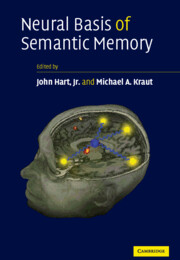Book contents
- Frontmatter
- Contents
- List of contributors
- Preface
- Part I Semantic Memory: Building Models from Lesions
- 1 Semantic refractory access disorders
- 2 The anatomical locus of lesion in category-specific semantic disorders and the format of the underlying conceptual representations
- Part II Insights from Electrophysiology
- Part III Applications of Models to Understanding Cognitive Dysfunction
- Part IV Representations of Nouns and Verbs vs. Objects and Actions
- Part V Critical Role of Subcortical Nuclei in Semantic Functions
- Part VI Conceptual Models of Semantics
- Index
- References
1 - Semantic refractory access disorders
from Part I - Semantic Memory: Building Models from Lesions
Published online by Cambridge University Press: 14 September 2009
- Frontmatter
- Contents
- List of contributors
- Preface
- Part I Semantic Memory: Building Models from Lesions
- 1 Semantic refractory access disorders
- 2 The anatomical locus of lesion in category-specific semantic disorders and the format of the underlying conceptual representations
- Part II Insights from Electrophysiology
- Part III Applications of Models to Understanding Cognitive Dysfunction
- Part IV Representations of Nouns and Verbs vs. Objects and Actions
- Part V Critical Role of Subcortical Nuclei in Semantic Functions
- Part VI Conceptual Models of Semantics
- Index
- References
Summary
Every individual has a vast thesaurus of conceptual knowledge. The cerebral organization of this knowledge base has intrigued philosophers for centuries and experimental psychologists for decades. By studying patients with brain lesions, neuropsychologists have been able to provide a powerful and direct source of evidence of the properties and organization of this conceptual knowledge base. This thesaurus is multifarious, encompassing words, objects, facts, people, places, and much more. In this chapter we will examine one particular neurological syndrome, “semantic refractory access dysphasia,” and hope to demonstrate that patients with this disorder can provide a window on the organization of conceptual knowledge.
The original studies of semantic memory impairment were concerned to establish the selectivity of the deficit, especially with regard to the integrity of other cognitive systems. The boundaries with episodic memory, propositional language, and perceptual systems were all explored (Warrington, 1975). However, these early studies of semantic memory impairment did not attempt to differentiate between impairments of access to an intact knowledge base and damage to or loss of stored conceptual knowledge itself. “Storage” deficits are attributed to damage to the central representations of concepts, resulting in a static/stable, consistent, item-specific, loss of knowledge. Such storage deficits can be contrasted with what are termed “access” deficits, which reflect the temporary unavailability of stored representations. We wish to clarify at the outset that the term “access” is not used to refer to impairments of transmission of input between different cognitive domains but rather to the instability of activation within a system.
Keywords
- Type
- Chapter
- Information
- Neural Basis of Semantic Memory , pp. 3 - 27Publisher: Cambridge University PressPrint publication year: 2007
References
- 5
- Cited by



